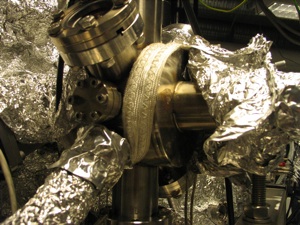Intro
This is a continuation of Intro to Vacuum Theory, and applies the concepts discussed the that document.
Issues with Vacuum Chambers
Contamination: molecules sticking to walls intermittently
molecules jumping around intermittently keeping the pressure too high
Main culprits
Water - from moisture in the air
attaches to chamber surfaces
Hydrocarbons (oils, plastics)
what if: leave a piece of plastic inside the vacuum chamber (oops!), then pump it down:
the plastic will outgas and coat the chamber walls with a fine layer of hydrocarbons
you know what's really oily? You.
Dust
it's all around us, slowly settling on surfaces.
Dust always matters. We try to avoid it. Sometimes a lot. Sometimes not so much.
how to defeat contamination
Prevent it!
- opening the chamber? pump nitrogen into it first, keep the nitrogen flowing while the chamber is open - prevents water from getting in.
nitrogen gas has no humidity, unlike air.
- use gloves, change them frequently
- clean anything going inside the vacuum chamber
- worried about dust? don't let it get in your chamber!
wear special dust-free clothes. Do vacuum work in a special dust free room.
Bake it
making the chamber hot will get help those sticky molecules (water and oil) to jump around more
we wrap the chamber in electrical heating tape to heat it from the outside in. it takes days.
detailed discussion see pages on baking
water: 150°C
hydrocarbons: 250°C
Leaks: always happening, hopefully tiny
sources of leaks
leaking in from the outside
- really big leaks can be heard, usually from something like a seal that wasn't tightened
- smaller leaks come from various places, often for example a hair sitting on a seal or ????
- tiny tiny leaks: individual gas molecules wriggle their way through materials (gas permeability), especially rubber, making a very slow leak.
all vacuum chambers leak, but the leak doesn't have to come from outside the chamber...
leaks from within the chamber
gas trapped in a pocket slowly leaks into the rest of the chamber - a virtual leak, eventually it runs out, but can take weeks.
The above diagram's screw has a hole drilled through the middle to allow the trapped gas to escape quickly. these are called 'vented screws' and are used commonly inside vacuum chambers. But there are other places gas can get trapped besides at the bottom of screw holes.
How do we find small leaks?
with helium.
For detailed discussion on leaks, how to find them, and what to do about them see the Leak Checking pages
How much is too much? Time to talk numbers
We use numbers and units in discussing vacuum systems. And the way vacuum uses some units can be very counterintuitive (*cough* log scale). This section breaks down the ideas behind the way we talk numbers around vacuum.
Units Used with Pressure
- we use torr to describe the pressure of our vacuum systems
image of vacuum guage used here at SLAC
- we use psi (pounds per square inch) to describe the pressure of our compressed systems
compressed: air, nitrogen, helium, argon, etc...
- we use liters per second (l/s) to describe the rate of gas flowing through something
Log Scales (making numbers lie)
Not this log scale:
The log scale I'm talking about... It's totally math. Sorry.
Log scale allows people to create graphs that show tiny things next to giant things really well by stretching out the distance between tiny numbers, and compressing the distance between huge numbers. The powers of 10 does this really well.
Exponents and powers of 10
The little number above the 10's, called the exponent, is the number of zeros.
you can remember 'exponent' because it exposes the number of zeros.
A negative exponent is how many zeros past the decimal place.
What's the difference between 107 and 103? the same difference between 10,000,000 and 1,000: over 9 million.
What's the difference between 10-7 and 10-3? the same difference between 0.00000001 and 0.0001: less (much less) than 1
-Different, but in both cases the difference is 4 orders of magnitude (4 zeros). look at the difference between exponents: 7 - 3 = 4, tiny or huge, doesn't matter.
Linear vs Logarithmic
In linear counting the numbers increase one at a time. It's what we're used to. it's how we normally count: 1, 2, 3, 4, 5, etc...
In logarithmic (i.e.: log) counting the numbers increase by bigger amounts each time. Log counting is strange, counterintuitive and, unfortunately, useful.
the log scale and the linear scale both start around 1 go up to 100,000. But what's different is how they get from 1 to 100,000. The second number in linear scale is 20,000, but in log scale the second number is only 10. Also in log scale the second to last number is 10,000, still much less than the second number in the linear scale: 20,000.
Common units that use log scales: sound (decibels: dB), earthquakes (Richter magnitude)
UHV: how few molecules
Ultra-High Vacuum (UHV) is an official term for really really fancy vacuum of a certain (extremely low) range of pressures. And it's the type of vacuum we care about the most.
For molecules in UHV the mean free path is at least 200 miles. Any molecule in UHV is going to see the chamber walls thousands of times before it will see another molecule.
Vacuum Chamber Construction
it's just a box for holding nothing.
Sadly the details of vacuum chambers and their construction is really beyond what this document is about (introduction to theory), but keep exploring!
For more details on Vacuum System parts and how they actually work, see the confluence pages on vacuum components
External resources
approachable, practical information on vacuum











